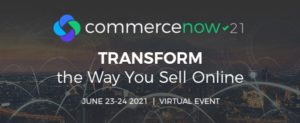As we’ve all noticed by now, the eCommerce landscape has been going through continuous shifts and growth recently, driven by the expansion of new markets and the technology boom. Especially in these last couple of years, due to the pandemic and the fast adaptability of the industry. So, it’s more than crucial to stay on top of the changes and up to date with the fresh trends from the eCommerce world.
Ecommerce industry thought leaders and innovators shared their insights on where this market is headed in the recent edition of our CommerceNow event, a one-of-a-kind online event for experts selling online.
In this blogpost, we will share some of the most insightful takeaways from two of the sessions that took place at this year’s CommerceNow virtual event. Sign up here to watch our complete recordings of the event on demand.
Read on to discover what industry experts Derric Haynie and Kevin Lee shared in terms of boosting your eCommerce growth with the right tools and adapting to the friction-free landscape.
“How to Choose the Right Tech Tools to Grow Your Store” was the topic of Derric Haynie’s presentation. Derric is the Chief eCommerce Technologist at EcommerceTech, and he walked us through his seven-step framework for successfully optimizing your tool stack.
Derric kicked off his presentation with an overview of the market tech landscape over the past several years. Collaborative tools, he pointed out, used to be single use, but now most businesses employ all-in-one solutions. Digitally native vertical brands are on the rise, and these innovative new brands are building online, omnichannel relationships with their customers.
“The user experience is changing—there’s two-day shipping, live chat, personalization, social sharing—and everyone is an influencer,” he pointed out. “A best-in-class shopping experience is expected.”
Before getting to his seven-step framework, Derric shared the high-level strategy skills all companies should have:
- A daily metrics dashboard, so you can see how all aspects of your business are running, and see problems and resolve them
- Split testing of product detail pages, landing pages, and home and category pages
- Customer development, including surveys, phone calls, reviews, social media, etc.
Derric also emphasized the importance of understanding your tech stack, singling out two different must-have types of tools: KPI-driven and time-saver tools. “KPI is where I’m focusing today,” he said.
Seven Steps to Optimize Your Tech Stack the “Right Way”
1. Conduct a needs analysis with all the pertinent stakeholders from your company, including the help-desk rep, the CEO, sometimes even the CFO. Your objective: “We need something that can do A, B, and C.”
2. Ask how it will integrate with the rest of your tech stack. You want a natural three-step integration, and there’s no such thing as data silos anymore.
3. What’s the budget? You want the highest ROI, not just the lowest price. “What kind of functionality will you lose with a cheaper solution?” Derric asked. You’re looking for a solution that will sustain you for three to four years, not just the short-term fix, he said. “See if you can grow into the bells-and-whistles of a more expensive solution.”
4. Understand the switching and lock-in costs.
5. Create a short list of tech tool candidates.
6. Demo up to five solutions, then narrow down to the best choices.
7. Test onboarding
- Split test on your website
- Set up the tool “to the fullest”—take the time to execute the tool you’ve chosen
According to Derric, here are some of the questions to ask about the tools you’re vetting:
- Is it built for eCommerce?
- What’s the tool’s focus area? Does it solve your problem(s)?
- Do you have the internal resources—team members—who can execute the tool?
- Is the tool priced fairly based on a value metric?
- Does this tool have unique features the other tools don’t have?
- Does this tool fit with the rest of your stack?
Derric also shared some quick tips for success when choosing a tool, as well as some specific examples of market solutions that address different areas (channel marketing, advertising, user-generated content), and the basics of how they could support your business.
Watch Derric’s entire session here to get all the tips and tricks on how to hyper grow your online store with the right tech tools.
_____________________
“Speed and convenience drive competitive advantage in the shopping experience,” shared Kevin Lee, Trust and Safety Architect at Sift, in his presentation “How Enterprise Companies Are Adapting to the Friction-Free eCommerce Landscape.”
Quick and easy transactions may be the holy grail, however, security is key in pursuit of this goal, and eCommerce risk teams are “fighting a war” on a number of different fronts, says Kevin. His presentation focused on the payments space of the fraud economy, looking at ways businesses are being exploited, especially from the marketing and conversion side, and how companies can use trust to their advantage.
“The fraud economy is a well-connected engine with many sources, especially as the digital economy has picked up. There are more and more people online, more ratings and reviews with fraud intent,” Kevin explained. “It’s more important than ever that other teams in the company are communicating with the fraud team and that systems are integrated.”
What causes the breakdown of trust? Kevin provided a list of the key factors to consider:
- Chargebacks
- Increased friction, which naturally leads to:
– Reduced engagement
– Reduced CLV
– Increased customer acquisition costs
- Negative PR
- Brand issues
- Legal
- Compliance
- Ops, engineering, and PM staffing
When Is It Time to Apply Dynamic Friction
“We want to make life miserable for the sub-1% of the shopper population who is fraudulent,” Kevin emphasized, but continued by mentioning that this should be done strategically so that only that 1% is impacted.
He walked the audience through an example, showing where dynamic friction can be applied to determine if a transaction is legitimate or fraudulent. When certain actions are taken by the shopper, additional info can be requested; you can play with the user journey, Kevin pointed out, to determine the next steps in the transaction.
What does a holistic solution look like? There are five essential layers, Kevin shared, which could be seen like a layer cake, with the steps happening from the bottom layer up:
- High-Volume Digestible Data Ingestion: When a user comes to your website, they come via different avenues. Have you looked at data from that journey to determine what legitimate user behavior looks like versus fraudulent user behavior?
- Machine Learning: Consumers want things to be really easy, and machine learning can make this possible.
- Workflow and Rules Automation: There is a time and a place for rules, but typically they are often used as a backstop, with machine learning the forward-facing tool that’s going to filter out the good from the bad.
- Analyst Tools and Feedback: Half of your investigation time is amassing data, so it’s important to have tools that can consolidate all this data to make the best decisions in the fastest amount of time.
- Reporting: You should know your fraud rates, chargeback rates, and “consumer insult” rates.
Kevin concluded his presentation with some key takeaways:
- Understand what data you may be collecting but not leveraging
- How do you measure the impact of fraud on your platform?
- What info does your overall team use that your risk team doesn’t?
- You can turn trust into a competitive advantage with dynamic friction.
- Understand the user journey
- Use machine learning to your advantage
- Create a platform that blends the strengths of all your tools
Check out Kevin’s full session here, to get all the insights on how to avoid friction and boost your eCommerce growth.
If you want to find out more about the best ways to scale your eCommerce shop into a thriving business, and learn all the actionable strategies that the leading experts in the industry have shared at CommerceNow ‘21, sign up here to get access to all the insightful sessions.








